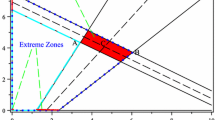Abstract
This paper focuses on solving systems of interval linear equations and interval linear programming in a computationally efficient way. Since the computational complexity of most interval enclosure numerical methods is often prohibitive, a procedure to obtain a relaxation of the interval enclosure solution that is computationally tractable is proposed. We show that our approach unifies the four standard interval solutions—the weak, strong, control and tolerance solutions. The interval linear system methods require \(n\cdot 2^{n}\) linear solutions. However, in the case of linear programming problems, we show that this requires just two optimization problem of the size of the problem itself. Numerical examples illustrate our results.
Similar content being viewed by others
References
Allahdadi M, Mishmast Nehi H (2013) The optimal solution set of the interval linear programming problems. Optim Lett 7:18931911
Allahdadi M, Mishmast Nehi H, Ashayerinasab HA, Javanmard M (2016) Improving the modified interval linear programming method by new techniques. Inf Sci 339:224236
Ashayerinasab HA, Mishmast Nehi H, Allahdadi M (2018) Solving the interval linear programming problem: a new algorithm for a general case. Expert Syst Appl 93:3949
Fiedler M, Nedoma J, Ramik J, Rohn J, Zimmermann K (2006) Linear optimization problems with inexact data. Springer, New York
Hladk M (2011) Tolerance analysis in linear systems and linear programming. Optim Methods Softw 26(3):381–396
Hladk M (2009) Optimal value range in interval linear programming. Fuzzy Optim Decis Making 8:283294
Hladik M (2010) How to determine basis stability in interval linear programming. Technical report KAMDIMATIA series (2010-973), Department of Applied Mathematics, Charles University, Prague
Jansson C (1997) Calculation of exact bounds for the solution set of linear interval systems. Linear Algebra Appl 251:321340
Jaulin L, Kieffer M, Didrit O, Walter E (2001) Applied interval analysis. Springer, London
Lodwick WA (1999) Constrained interval arithmetic. Technical report, University of Colorado at Denver. http://ccm.ucdenver.edu/reports/rep138.pdf
Lodwick WA, Dubois D (2015) Interval linear systems as a necessary step in fuzzy linear systems. Fuzzy Sets Syst 274:227–251
Lodwick WA, Jenkins OA (2013) Constrained intervals and interval spaces. Soft Comput 178:13931402
Moore RE, Kearfott RB, Cloud MJ (2009) Introduction to interval analysis. SIAM, Philadelphia
Neumaier A (1990) Interval methods for systems of equations. Cambridge University Press, Cambridge
Oettli W (1965) On the solution set of a linear system with inaccurate coefficients. SIAM J Numer Anal 2:115–118
Shary SP (2015) New characterizations for the solution set to interval linear systems of equations. Appl Math Comput 265:570573
Skalna I (2017) Strong regularity of parametric interval matrices. Linear Multilinear Algebra. https://doi.org/10.1080/03081087.2016.1277687
Rohn J (2009) Forty necessary and suffient conditions for regularity of interval matrices: a survey. Electron J Linear Algebra. https://doi.org/10.13001/1081-3810.1327
Rump SM (2017) INTLAB - INTerval LABoratory. http://www.ti3.tu-harburg.de/rump/intlab/
Acknowledgements
The authors would like to thank the anonymous reviewers for their valuable comments and suggestions to improve the quality of the paper. The third author wishes to thank CNPq project #400754/2014-2 for partially supporting this research.
Author information
Authors and Affiliations
Corresponding author
Ethics declarations
Conflict of interest
The authors declared that they have no conflict of interest.
Additional information
Communicated by V. Loia.
Publisher's Note
Springer Nature remains neutral with regard to jurisdictional claims in published maps and institutional affiliations.
Appendix
Rights and permissions
About this article
Cite this article
Mohaghegh Tabar, M., Keyanpour, M. & Lodwick, W.A. Solving interval linear programming problems with equality constraints using extended interval enclosure solutions. Soft Comput 23, 7439–7449 (2019). https://doi.org/10.1007/s00500-018-3388-2
Published:
Issue Date:
DOI: https://doi.org/10.1007/s00500-018-3388-2





